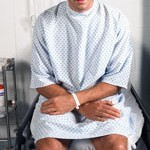
Peyronie’s disease is an abnormal curvature or bend of the penis that occurs when the penis is erect. Typically most curved penises are natural and non-painful, but in extreme cases, like Peyronie’s disease, the curvature or bend can be extremely painful.
What causes Peyronie’s disease?
The disease is most commonly associated with a fibrous scar tissue that is present under the skin of the penis itself. In some cases, the presence of the scar tissue is unknown, but in most cases, the tissue is the result of a fractured penis. The fracture of the penis can occur during intercourse and can lead to Peyronie’s disease. There is also a link to the disease from patients who receive surgery or radiation therapy for prostate cancer. There are also links to genetically being predisposed to experience this disease.
Despite being caused by several common factors, the disease remains quite rare and typically affects men between the age of 40 and 60. The curvature can occur alongside another disease called Dupuytren’s contracture which is a painless thickening the tissue beneath the skin of the palms on one or both hands. This disorder is more common and typically strikes white males who are over the age of 50. Despite the more common nature of Dupuytren’s contracture, very few men also develop Peyronie’s disease.
What are the Symptoms of the disease?
Typically the issues most commonly experienced with Peyronie’s disease is a large bend in the penis that occurs where there is an unusual hardening or scar tissue present. The penis may also narrow or be shortened as a result of the disease, which makes patients an ideal candidate to consider penis enlargement. The pain caused by the unnatural curvature can also make sexual intercourse difficult or painful and can make penetration impossible.
How to treat Peyronie’s disease?
In some cases, treatment may not be needed. As stated above, some curvature is normal, even with scar tissue or some hardening present as they can diminish over time. If symptoms persist then treatment may need to be considered. Typically, corticosteroid injections into the fibrous band is a common treatment that helps improve symptoms. There are medications like Potaba that may be taken orally, a high blood pressure medicine Verapamil can be injected, and even vitamin E has been shown to help heal the disease. In extreme cases radiation therapy, shock wave lithotripsy, and even surgery may be needed. It should be noted that in some cases that surgery on the penis can cause impotence, also known as Erectile Dysfunction (or ED). Surgery should be only attempted if sexual intercourse is impossible either through penetration, or through intense pain.
Are there any other alternatives to those mentioned above?
There has been progress reported by those using penis extender technologies. Penis extenders are devices that employ the use of a strap to keep the penis in place while tension is placed on the penis, stretching it out in its flaccid form. Due to the penis being flaccid, scar tissue can be broken up and extended to help straighten the penis. Although primarily used to extend the length of the penis, penile enlargers can help to reduce the pain of both erection and penetration through their use.
What is the bottom line about this disease?
There is a high chance for the disease to get worse once initially injured and at its worst, the penis may be rendered impotent. It is advised that anyone experiencing an injury to the penis should see a doctor or head to an emergency room immediately. If symptoms are formed a doctor should check out the area and advise you on your potential sources of treatment. Keep in mind that a little curvature is normal and may not be Peyronie’s disease. If, however, the symptoms persist or even get worse, you may need to consider your options and follow up with your health care provider. Always consult a doctor before beginning any treatment including a penis extender, as there are factors you may not be aware of before attempting to correct the issue yourself.
Although this can be a debilitating disease, it doesn’t have to be. There are options out there for the men dealing with this ailment. Know that you are not alone and that there is hope.






